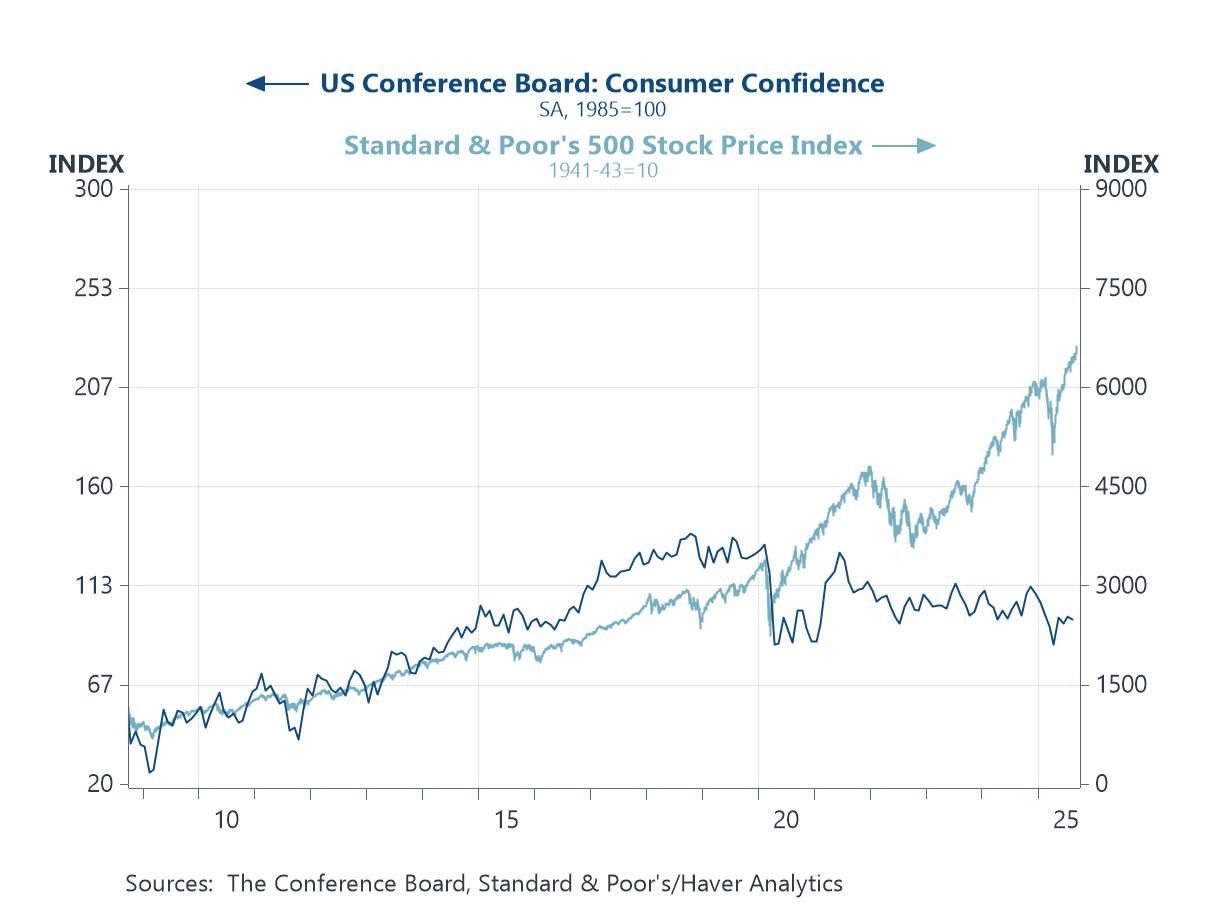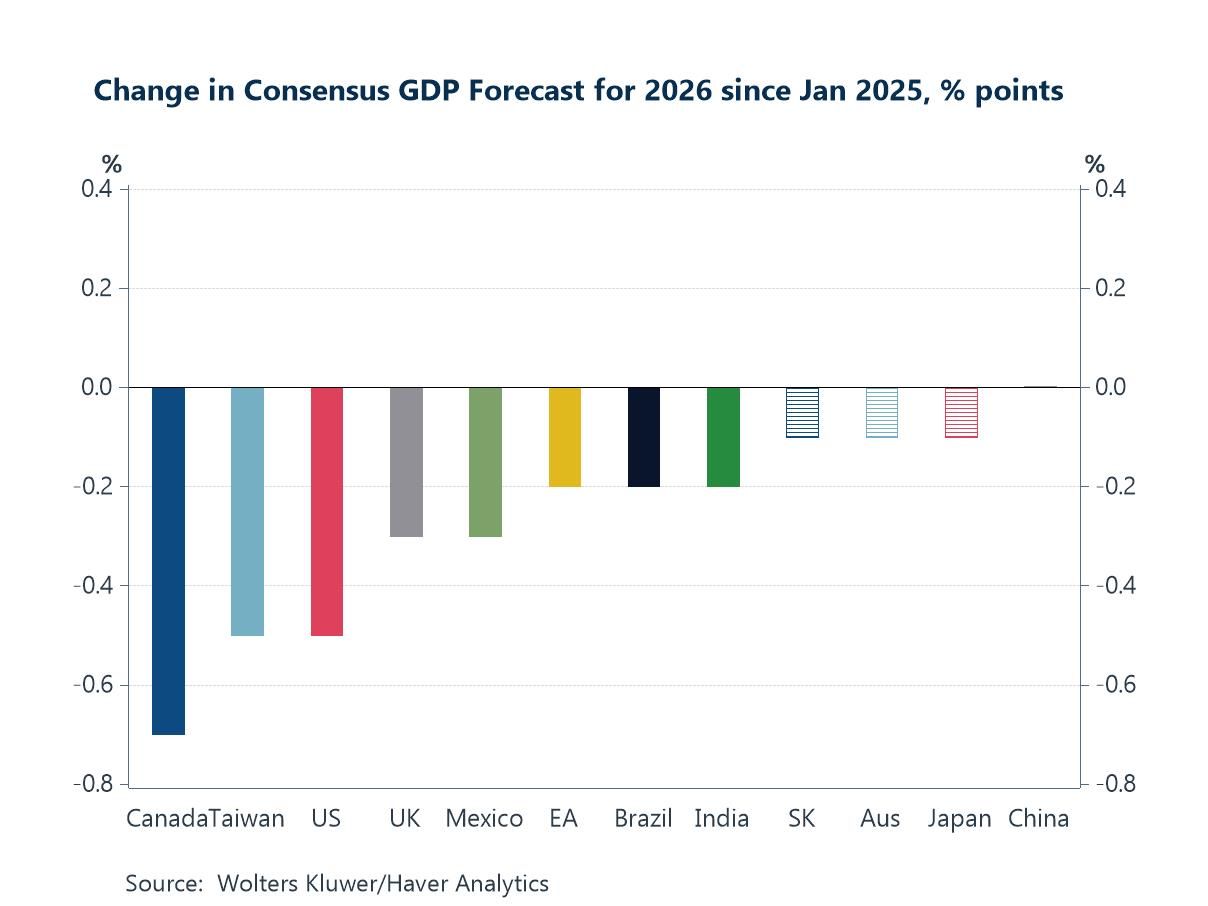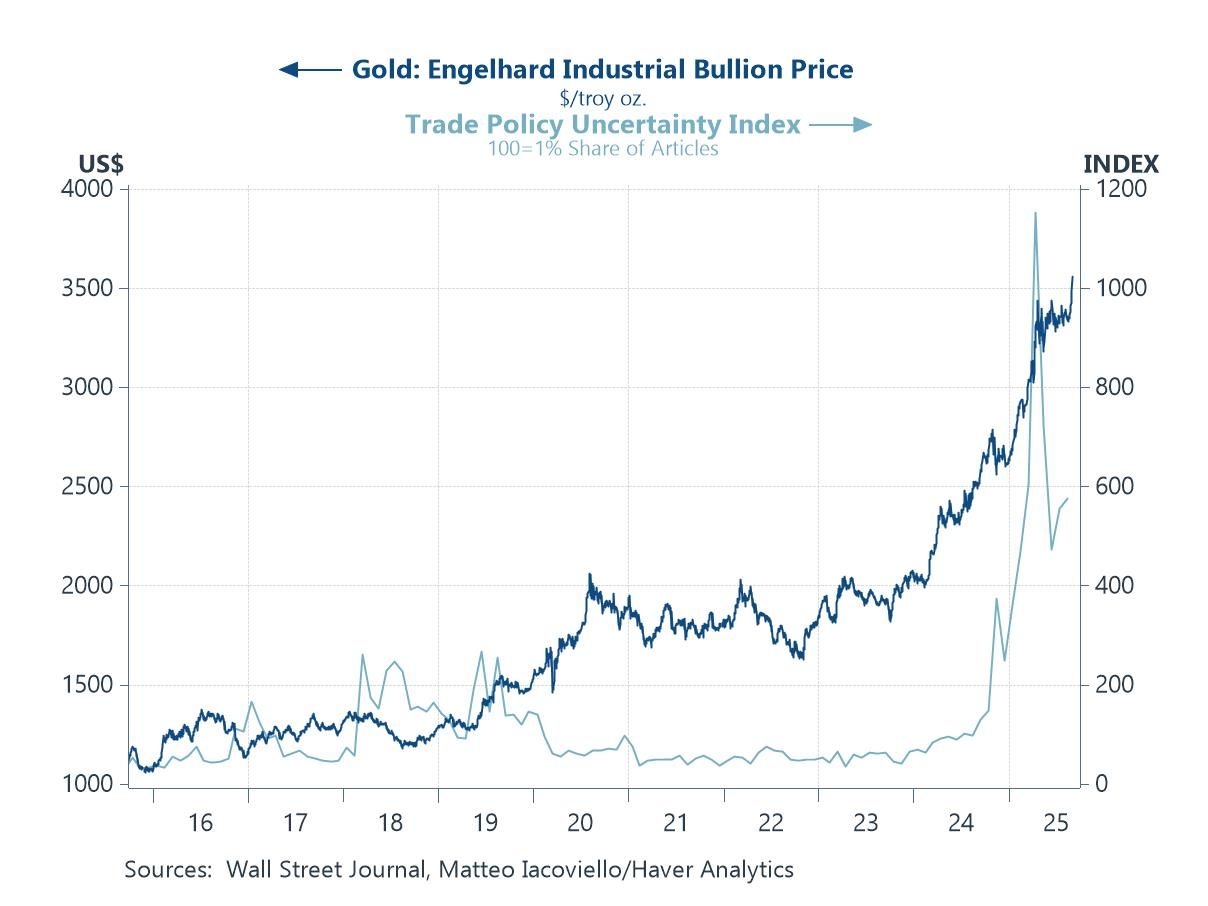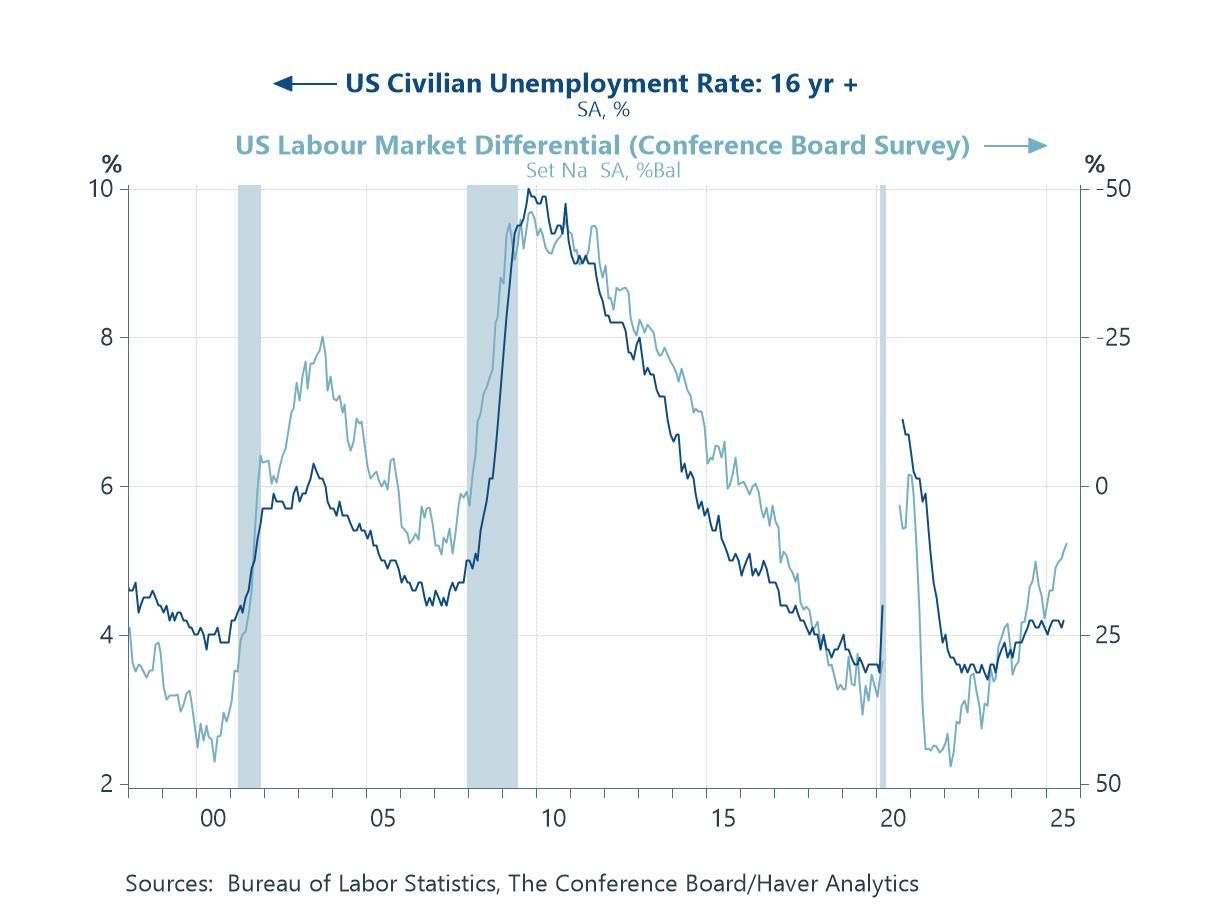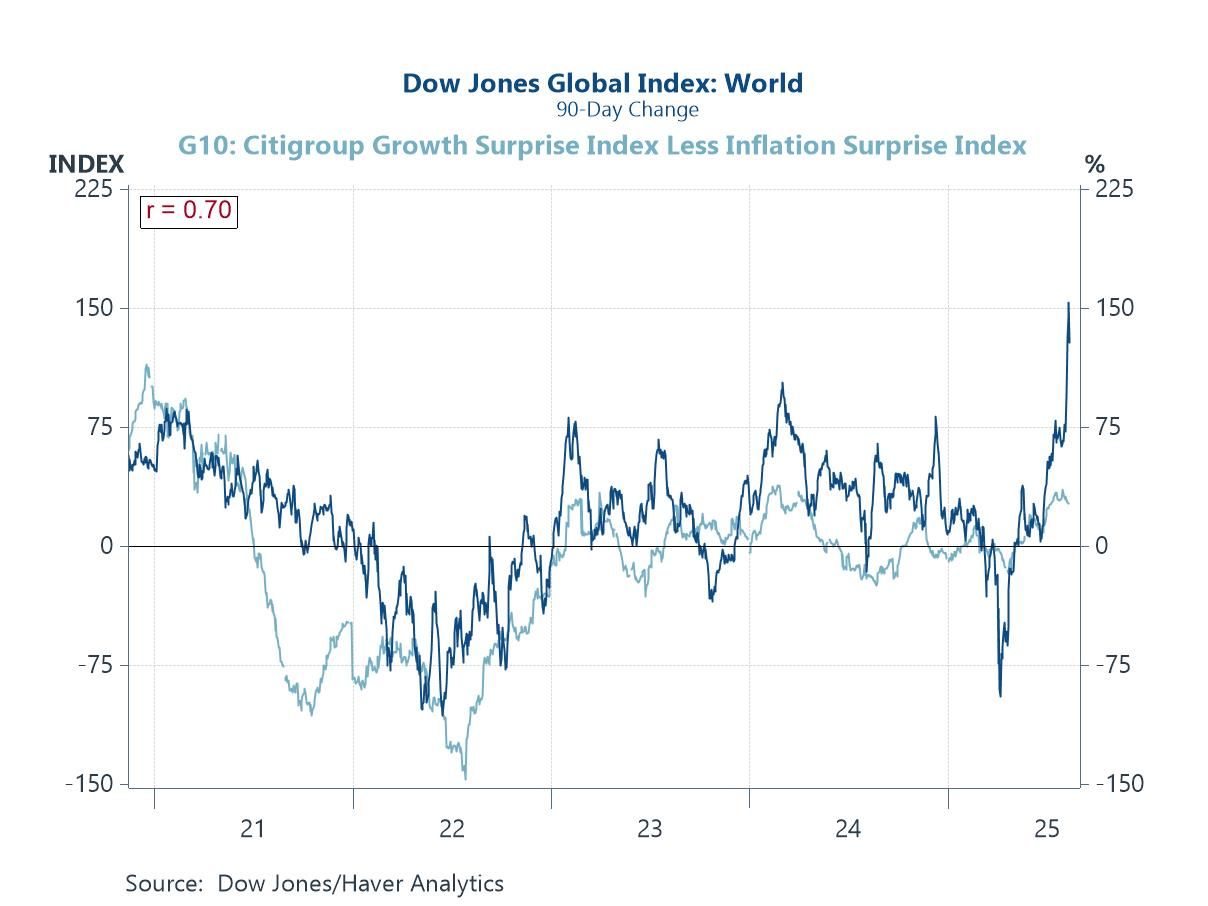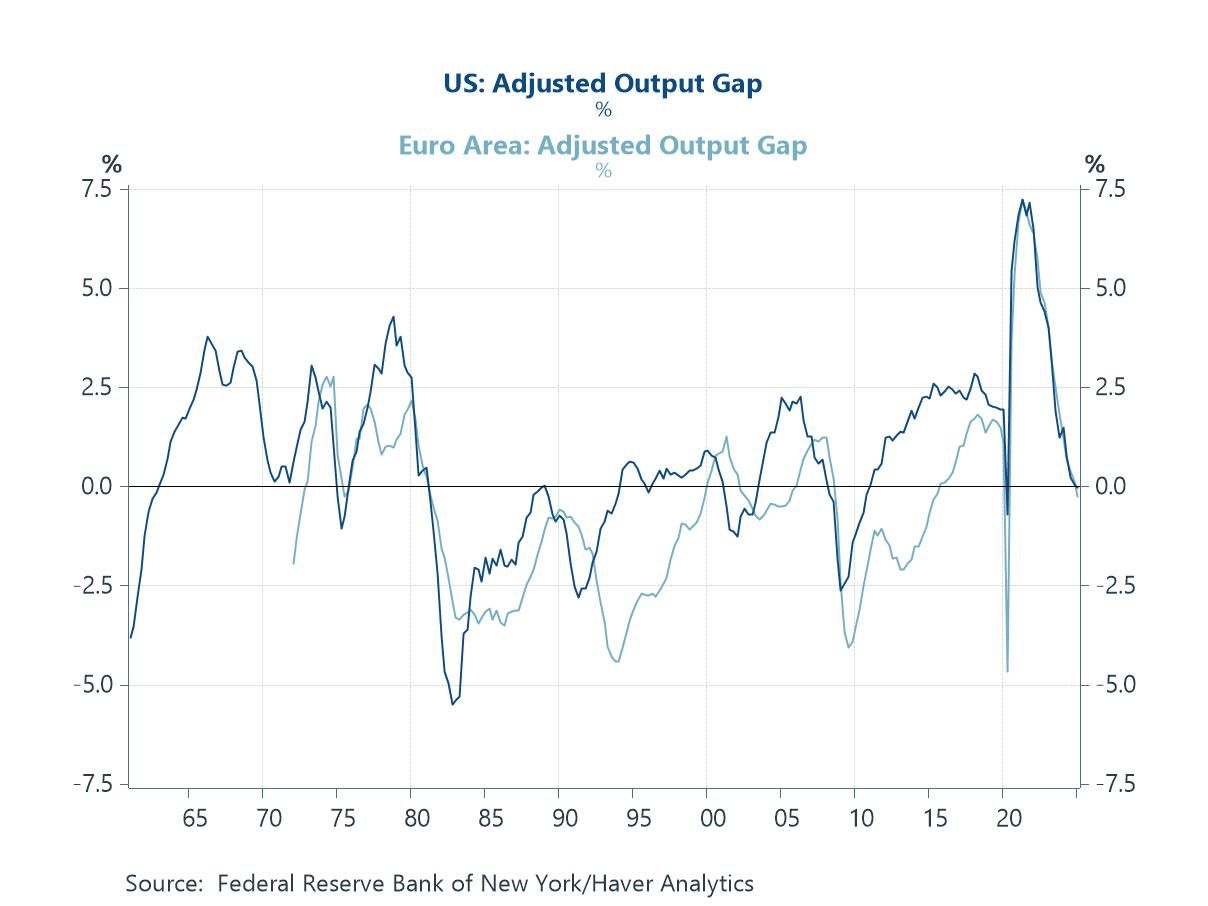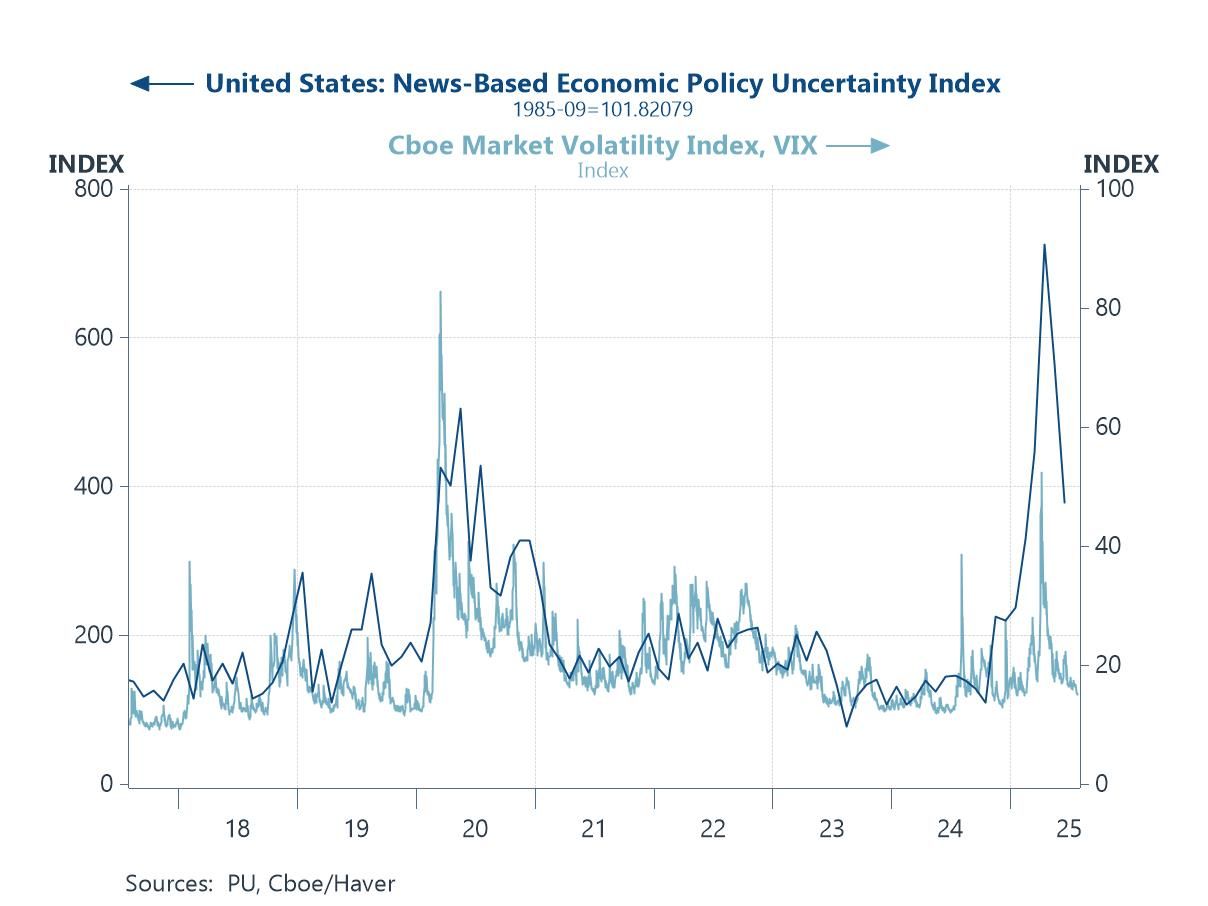The AI boom has revived the old promise that a wave of general-purpose technology will lift labour productivity everywhere. But sector mix matters. The chart below shows where recent job growth has actually happened: healthcare and social care. Since end-2023, employment in that sector has grown 3–4x faster than overall payrolls in the US, UK and Japan, pushing healthcare’s share of total jobs toward 14–15%. The euro area has been softer, but the direction is similar. Ageing populations and long-COVID backlogs are doing the heavy lifting. But the composition effect is awkward for macro optimists: healthcare is labour-intensive, highly regulated and only partly tradable—characteristics that usually come with lower measured productivity growth.
Introducing
Andrew Cates
in:Our Authors
Andy Cates joined Haver Analytics as a Senior Economist in 2020. Andy has more than 25 years of experience forecasting the global economic outlook and in assessing the implications for policy settings and financial markets. He has held various senior positions in London in a number of Investment Banks including as Head of Developed Markets Economics at Nomura and as Chief Eurozone Economist at RBS. These followed a spell of 21 years as Senior International Economist at UBS, 5 of which were spent in Singapore. Prior to his time in financial services Andy was a UK economist at HM Treasury in London holding positions in the domestic forecasting and macroeconomic modelling units. He has a BA in Economics from the University of York and an MSc in Economics and Econometrics from the University of Southampton.

Publications by Andrew Cates
 Global| Sep 22 2025
Global| Sep 22 2025AI, Baumol, and the Healthcare Hump
by:Andrew Cates
|in:Viewpoints
 Global| Sep 18 2025
Global| Sep 18 2025Charts of the Week: Faith in the Fed, Faith in Fiber
Global equity markets have remained near record highs over the past few days following the Fed’s 25bp cut on Wednesday, and which investors have seen as a key prop even without a full dovish pivot. AI optimism is also arguably doing some heavy lifting: markets are pricing a step-change in economy-wide productivity and margins from AI adoption, lifting multiples—especially among AI-exposed companies. However, some of this week’s charts frame the hurdles those hopes must clear: US consumer confidence remains subdued even as equities rise (chart 1); the Fed’s forward path is potentially becoming more politicised and inflation expectations have not softened in line with oil (chart 2); economists’ 2025 profit growth forecasts, in the meantime, have been marked lower and dispersion is wide, leaving valuations reliant on an AI-led earnings re-acceleration (chart 3). Elsewhere in Asia, earlier and ongoing easing underscores weak domestic demand and tariff risks rather than robust momentum (chart 4). Commodity dynamics could help at the margin—food prices have eased on better harvests and smoother supply chains (chart 5). Finally, and ahead of this week’s BoE decision in the UK, elevated services inflation tied to still-lofty pay growth is complicating the scope for further policy easing. In sum, the equity narrative arguably leans heavily on AI delivering tangible, near-term earnings power while policy remains credible and inflation contained; disappointment on any front in other words could challenge today’s valuations.
by:Andrew Cates
|in:Economy in Brief
 Global| Sep 11 2025
Global| Sep 11 2025Charts of the Week: Labouring the Point
Financial markets have spent the week recalibrating after last Friday’s much weaker-than-expected US payrolls data: government bond yields have declined sharply, while equity markets have remained perky off hopes of a gentler policy path and still-resilient earnings. Even so, the medium-term growth lens has dimmed—since January, consensus GDP forecasts for 2026 have been marked down across most major economies, reflecting a tougher trade regime and geopolitical frictions (chart 1). Turning to the data, the BLS’s preliminary payroll benchmark revision shaved 911k jobs from US employment from April 2024 to March 2025, confirming the idea of a broader cooling in hiring (chart 2). Within that softer backdrop, the composition of job creation has tilted further toward healthcare and social care - not just in the US - supporting headcount but possibly diluting aggregate productivity (chart 3). Elsewhere, China’s latest trade print highlighted a continued rotation of exports away from the US toward other Asian economies (chart 4). On vulnerabilities, France’s private-sector debt leverage—well above peers—underscores that crises more often spring from private balance sheets than sovereign ones (chart 5). And, finally, fears that new US tariffs would reignite supply-chain pressures continue to look overstated, at least for now (chart 6).
by:Andrew Cates
|in:Economy in Brief
 Global| Sep 04 2025
Global| Sep 04 2025Charts of the Week: A Few Cuts More
Equity markets have lost a little ground in recent days and bond markets have been more jittery, as legal challenges to US tariff policies add to a tense backdrop of geopolitical meetings between China, Russia, and India. Gold’s surge to record highs arguably captures the search for safe havens amid this uncertainty (chart 1), while the possibility of tariff reversals keeps alive the prospect of relief for the most affected exporters, notably China, Japan, and South Korea (chart 2). India’s position looks more precarious, with its reliance on the US market colliding with a weakening trade-weighted currency as tariffs bite into growth and investor confidence (chart 3). Monetary policy expectations, however, continue to offer some support, with the latest Blue Chip Financial Forecasts survey pointing to sizeable easing in the US and UK (chart 4). The ECB is expected to tread more cautiously after earlier cuts and with headline inflation now near target. Still, if inflation continues to ease, further action remains possible (chart 5). In the US, corporate resilience is also helping offset some of the gloom: despite tariff-driven spikes in non-labour costs, falling unit labour costs—possibly aided by AI productivity gains—and firmer prices allowed profits per unit of output to rise in Q2 (chart 6).
by:Andrew Cates
|in:Economy in Brief
 Global| Aug 28 2025
Global| Aug 28 2025Charts of the Week: Riskbusters
Global markets have continued to rally into late summer, buoyed by AI optimism, dovish signals from central bankers at Jackson Hole, and expectations of easier policy ahead. Yet beneath the surface, risks to the world economy are accumulating. In the US, labour market indicators point to softening conditions (chart 1), while tariff-driven pressures are beginning to push goods prices higher (chart 2). Global trade flows are being reshaped by US policy, with China’s excess capacity increasingly diverted toward Europe, most visibly through surging exports of electric vehicles (EVs) (charts 3 and 4). At the same time, wage growth remains stubbornly elevated in the UK, complicating disinflation (chart 5), while concerns are mounting over the country’s external vulnerabilities as net FDI and portfolio positions weaken against the backdrop of jittery debt markets (chart 6). Together, these dynamics highlight the tension between buoyant market performance and a global economy still grappling with structural fragilities.
by:Andrew Cates
|in:Economy in Brief
 Global| Aug 21 2025
Global| Aug 21 2025Charts of the Week: Cracks Beneath The Shine
Recent financial market gains have been underpinned by resilient global data, AI-fuelled optimism, and hopes that most central banks will continue to loosen monetary policy. Yet beneath the surface, a more complicated picture may be emerging. In the US, housing indicators are flashing warnings about household balance sheets and credit channels (chart 1), while China’s latest data—covering retail sales, industrial output, and property—underscore persistent weakness (chart 2). In the UK, this week’s data showing sticky services inflation is complicating the Bank of England’s easing path (chat 3), while back in the US, medium-term inflation expectations have been rising despite softer oil prices (chart 4), hinting at a more disruptive role for trade policy. Against this cyclical backdrop sit deeper structural challenges: global energy consumption remains overwhelmingly dependent on fossil fuels, the clean energy sector has lost momentum amid high costs and policy uncertainty, and equity markets have punished renewables even as climate imperatives intensify (charts 5 and 6). Together, these dynamics suggest that while markets continue to trade on optimism, the mix of weak housing signals, patchy Chinese demand, sticky inflation, and an uneven energy transition potentially leaves the global outlook more fragile than headline performance implies.
by:Andrew Cates
|in:Economy in Brief
 Global| Aug 19 2025
Global| Aug 19 2025Powering Prosperity: Why the UK Has Been Falling Behind
Energy is not just another input into an economy — it is the foundation on which productivity, competitiveness, and long-term growth rest. The capacity to generate abundant, reliable, and affordable electricity underpins industrial strength, attracts investment, and enables technological transformation. Where these conditions are met, economies flourish; where they are absent, the result is stagnation.
That is why the UK’s dismal record on per-capita GDP growth over the past five years — one of the weakest among advanced economies — cannot be understood without reference to its electricity system. High prices, declining per-capita generation, and an energy mix that has failed to replace retiring firm capacity with equally reliable low-carbon alternatives have eroded competitiveness. By contrast, the United States has combined low electricity prices with high and stable per-capita generation, giving it a structural advantage in attracting energy-intensive industries and supporting the AI- and manufacturing-led investment boom.
by:Andrew Cates
|in:Viewpoints
 Global| Aug 14 2025
Global| Aug 14 2025Charts of the Week: What Gives?
Global financial markets head into late summer buoyed by resilient risk appetite, underpinned by hopes that AI will boost productivity and growth alongside expectations for further central bank policy easing (chart 1). Yet this optimism has not been fully mirrored in the macro outlook: US non-residential investment forecasts for 2026 have been marked down in recent months, and global growth projections — particularly for US-exposed economies — have also softened, arguably reflecting tariff-related uncertainty (charts 2 and 3). This week’s data have nevertheless been friendly for the idea that further policy easing will be enacted in the months ahead. In the US, a benign July inflation report has, for example, bolstered expectations of a September Fed rate cut (chart 4). And in the UK, weaker labour market data have raised hopes of further BoE easing despite the hawkish tone that accompanied last week’s rate cut (chart 5). Meanwhile, falling global energy prices are also providing an important counterweight to the inflationary risks posed by US tariff measures, a balance that could be central in shaping the path of interest rates into year-end (chart 6).
by:Andrew Cates
|in:Economy in Brief
 Global| Aug 07 2025
Global| Aug 07 2025Charts of the Week: Downside Risks
Last week’s weaker-than-expected US labour market report—marked by sluggish payroll growth, rising unemployment, and downward revisions to prior months—sparked a notable shift in financial markets. Bond yields fell sharply as investors repriced the outlook for Fed easing, with rate cut expectations brought forward. This recalibration arguably reflects growing awareness of mounting downside risks across the US and broader global economy. Several indicators reinforce this view. Output gaps in many major economies are narrowing or turning negative, signalling that demand is falling short of potential (chart 1). The US housing market looks fragile, amidst weak builder sentiment and falling prices (chart 2). US bank lending standards are still restrictive, with implications for credit availability, household and business investment, and overall economic momentum (chart 3). Some (though not all) global sentiment surveys have softened, and positive growth surprises are now fading. Meanwhile, and despite earlier fears, US tariffs have not triggered renewed supply chain stress or inflationary pressures (chart 5). Add to that the ongoing deflation in China’s producer prices, and the macro narrative could be tilting more decisively toward slower growth and diminishing inflation risks—leaving policymakers with more space to continue easing monetary policy (chart 6).
by:Andrew Cates
|in:Economy in Brief
 Global| Jul 31 2025
Global| Jul 31 2025Charts of the Week: Markets Rally, Risks Linger
Financial markets have performed well in recent weeks, lifted by stronger data, moderating inflation, and renewed soft landing hopes. Equities have pushed higher, volatility has eased, and credit markets have firmed. While economic policy uncertainty remains elevated, it is showing signs of normalising alongside greater clarity on US trade policy (chart 1). The US dollar, however, remains under pressure amid concerns about Fed independence and broader policy credibility (chart 2). The Fed’s decision on July 30th to leave policy on hold, despite two dissenting votes in favour of a cut, arguably did little to ease those concerns. Recent US trade agreements—particularly with Japan and Europe—have boosted sentiment, though questions linger over implementation. In Japan, trade policy uncertainty has surged amid vague deal terms, even as exports to the US have weakened (chart 3). In the euro area, M3 growth slowed in June as private credit softened, casting doubt on the durability of recent upside surprises (chart 4). UK retail data signal a sharp drop in consumer activity, consistent with past recessions (chart 5), and the change in US house prices has turned negative on a three-month basis—often a warning sign of broader economic weakness (chart 6). Overall, while market sentiment has improved, risks tied to credit, demand, and housing persist.
by:Andrew Cates
|in:Economy in Brief
 Global| Jul 08 2025
Global| Jul 08 2025Charts of the Week: Summer Resilience
There will be no Charts of the Week publication for the next couple of weeks. The next edition will be released on Thursday, July 30th.
Recent buoyancy in global equity markets reflects a welcome mix of encouraging signals: growth is holding up better than many feared, inflation surprises have turned more benign, and most major central banks are poised to continue lowering interest rates in the period immediately ahead (charts 1, 2 and 3). There are, however, pockets of strain beneath the surface. Trade growth in Asia has slowed, most visibly in exports to the US, as tariffs and lingering tensions weigh on key sectors (chart 4). At the same time, China’s rising capital outflows point to firms and investors hedging their bets by shifting more assets abroad (chart 5). These undercurrents hint at an uneven global picture where trade frictions and capital shifts could test the durability of the recent calm. On a more positive note, the strong, steady climb in renewable energy production is a bright spot, underscoring the scale of investment pouring into the clean energy transition—even as real energy costs remain firm (chart 6). Altogether, while the broader backdrop remains supportive, new trade barriers, shifting capital flows, and the hidden costs of the green transition are watchpoints that could unsettle markets if growth momentum stalls or policy missteps occur.
by:Andrew Cates
|in:Economy in Brief
 Global| Jul 02 2025
Global| Jul 02 2025Charts of the Week: Headwinds and Heatwaves
Financial markets have remained generally buoyant in recent days, with global equity indices advancing on the back of relatively upbeat global growth data, benign European inflation readings and the prospect of further policy easing from major central banks. At the same time, the US dollar has continued to weaken, reflecting a run of disappointing US economic data and rising investor concerns about the fiscal outlook, even as European growth surprises have turned more positive. This divergence, combined with the prospect of lower US policy rates relative to some (though not all) peers, has added to the dollar’s drift lower (charts 1 and 2). Supply chain strains—highlighted by elevated vessel queues at US West Coast ports—also feed into the narrative that US tariff measures may be contributing to sticky input costs and stagflation risks (charts 3 and 4). Meanwhile, record temperatures in parts of Europe this week have reinforced the climate challenge facing policymakers, with the final two charts illustrating how rising global temperatures and heat stress could increasingly weigh on productivity and growth potential if left unchecked. With trading volumes light ahead of the July 4th holiday and markets awaiting tomorrow’s US non-farm payrolls report, the interplay between softer US data, resilient equities, a weaker dollar, and climate-related risks remains firmly in focus.
by:Andrew Cates
|in:Economy in Brief
- of20Go to 2 page


